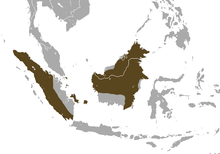大樹鼩
外觀
| 大樹鼩 | |
|---|---|

| |
| 科學分類 | |
| 界: | 動物界 Animalia |
| 門: | 脊索動物門 Chordata |
| 綱: | 哺乳綱 Mammalia |
| 目: | 攀獸目 Scandentia |
| 科: | 樹鼩科 Tupaiidae |
| 屬: | 樹鼩屬 Tupaia |
| 種: | 大樹鼩 T. tana[1]
|
| 二名法 | |
| Tupaia tana[1] Raffles, 1821
| |

| |
| 大樹鼩分布範圍 | |
大樹鼩(學名:Tupaia tana)是樹鼩屬的一個種。[1]它原產於蘇門答臘和鄰近的小島,以及婆羅洲的低地和丘陵。[3]
棲息地
[編輯]大樹鼩是所有樹鼩物種中最主要的陸生物種。它們通常在森林地面上,這是它們覓食的主要地點,儘管它們也有一部分時間在樹上。[4]根據野外觀察及其形態特徵,大樹鼩被描述為主要陸生。[5][6]大樹鼩主要生活在原始熱帶雨林中,但在沼澤森林和次生林中也有發現。大樹鼩有許多潛在的捕食者,例如紋貓、豹和雲豹。
描述
[編輯]大樹鼩比普通樹鼩稍大。[4]背毛呈紅棕色,後部漸近黑色。有一條黑色條紋從脖子的一半延伸到背部的三分之二處,直到它消失在較暗的後部皮毛中。
該物種的體型測量值是:
大樹鼩有靈敏的聽覺和大眼睛,這使它具有敏銳的夜視能力,[7]但白天的視力很差。
飲食習慣
[編輯]它們的食物包括蚯蚓和節肢動物,如蜈蚣、千足蟲和甲蟲幼蟲,以及一些水果。[3]不太喜歡的節肢動物包括螞蟻、甲蟲、蜘蛛、蟑螂和蟋蟀。
繁殖
[編輯]雄性和雌性的平均生殖成熟年齡都在一歲左右。雌性幾乎總是生下兩個晚熟的幼崽。在質量差的地區或資源稀缺時期,雌性的繁殖力會降低。[8]
參考資料
[編輯]- ^ 1.0 1.1 Helgen, K.M. Tupaia tana. Wilson, D.E.; Reeder, D.M. (編). Mammal Species of the World: A Taxonomic and Geographic Reference 3rd. Johns Hopkins University Press. 2005: 108. ISBN 978-0-8018-8221-0. OCLC 62265494.
- ^ 2.0 2.1 Cassola, F. Tupaia tana. The IUCN Red List of Threatened Species. 2016: e.T41501A22279356 [26 January 2022]. doi:10.2305/IUCN.UK.2016-2.RLTS.T41501A22279356.en
 .
.
- ^ 3.0 3.1 3.2 Payne, J., Francis, C. M., Phillipps, K. (1985). Field guide to mammals of Borneo. The Sabah Society with World Wildlife Fund Malaysia.
- ^ 4.0 4.1 Yasuma, S., Andau, M., Apin, L., Yu, F.T.Y., and Kimsui, L. (2003). Identification keys to the mammals of Borneo: Insectivora, Scandentia, Rodentia and Chiroptera. Park Management Component BBEC Programme, Sabah.
- ^ Emmon, L. (2000). Tupai: a Field Study of Bornean Treeshrews. University of California Press, Berkeley, Los Angeles.
- ^ Wells, K., Pfeiffer, M., Lakim, M. B., and Kalko, E. K. V. (2006). Movement trajectories and habitat partitioning of small mammals in logged and unlogged rain forest on Borneo. Journal of Animal Ecology 75(5): 1212–1223.
- ^ Harwood, R. Geology 102: Humans. [2009-08-03]. (原始內容存檔於2010-06-25).
- ^ Munshi-South, J. Female-biased dispersal and gene flow in a behaviorally monogamous mammal, the large treeshrew (Tupaia tana). PLOS ONE. 2008, 3 (9): e3228. Bibcode:2008PLoSO...3.3228M. PMC 2528962
 . PMID 18797506. doi:10.1371/journal.pone.0003228
. PMID 18797506. doi:10.1371/journal.pone.0003228  .
.

